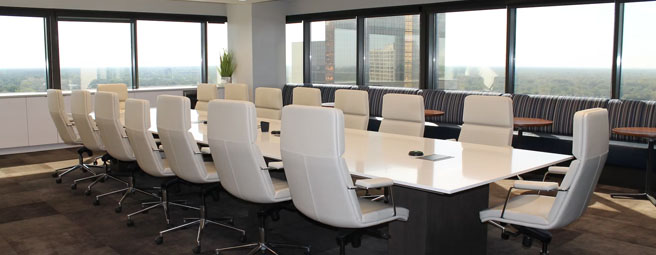
How Big Should My Conference Rooms Be?
Conference Room Dimensions: A Strategic Guide for Modern Businesses
Planning effective meetings starts with the right space. Whether you are hosting intimate team discussions or large-scale presentations, understanding optimal conference room dimensions is crucial for fostering productivity and comfort.
The size of your conference room directly impacts collaboration, engagement, and overall meeting success. Too small, and participants feel cramped and distracted. Too large, and the space can inhibit connection and create acoustical challenges. Industry standards suggest allocating 15 to 20 square feet per person for comfortable seating and movement.
Davinci Virtual Offices provides room dimensions that transforms meeting dynamics. Right-sized spaces lead to better participation, improved focus, and more successful outcomes. This comprehensive guide will help you determine the perfect conference room dimensions for your specific needs, ensuring your meetings achieve their full potential.
The Importance of Proper Conference Room Dimensions
The dimensions of your conference room play a pivotal role in shaping meeting dynamics and outcomes. While often overlooked, proper space allocation directly influences how participants interact, collaborate, and perform during meetings.
Impact on Productivity and Engagement
Conference room size significantly affects participant focus and interaction. In appropriately sized spaces, attendees can maintain comfortable personal space while remaining close enough to engage meaningfully with presentations and discussions. When dimensions are well-planned, participants can easily view displays, hear speakers clearly, and contribute to conversations without straining.
Proper conference room dimensions also facilitate natural movement and spontaneous collaboration. With adequate space between seats, participants can turn to face speakers, form breakout groups, or approach presentation areas without disrupting others. This freedom of movement keeps energy levels high and encourages active participation.
Comfort and Well-being
Beyond productivity, conference room dimensions directly impact attendee comfort and health. Properly sized rooms provide sufficient air circulation, reducing CO2 buildup that can lead to drowsiness and decreased concentration. Good spacing between participants helps maintain comfortable temperature levels and reduces the spread of airborne illnesses.
Ergonomic considerations also depend heavily on room size. Adequate dimensions allow for proper seating arrangements that support good posture and reduce physical strain during extended meetings. Participants should have enough space to adjust their positions, stretch occasionally, and maintain a comfortable viewing angle to screens or presenters.
Moreover, appropriate room dimensions help manage psychological comfort. Overcrowded spaces can create anxiety and stress, while overly large rooms can feel intimidating or impersonal. The right balance creates an environment where participants feel at ease, leading to more productive discussions and better meeting outcomes.
Average Conference Room Sizes Based on Number of Participants
When planning your conference room dimensions, understanding standard size requirements for different group sizes is essential. Whether you are hosting intimate team meetings or large-scale presentations, proper space allocation ensures comfort and productivity for all participants.
Small Conference Rooms (Up to 4 People)
Small conference rooms typically require approximately 100 square feet of space. These intimate settings are perfect for focused discussions, job interviews, and small team meetings. The dimensions should allow for a compact table while maintaining comfortable circulation space. For a comfortable workspace for four people without feeling cramped, a minimum of 10’ x 10’ space is recommended.
Medium Conference Rooms (5 to 10 People)
For medium-sized groups of 5 to 10 people, conference room dimensions should range between 150 to 250 square feet. These spaces commonly host team meetings, client presentations, and collaborative work sessions. A room measuring 15’ x 15’ or 12’ x 20’ provides adequate space for a larger table, presentation equipment, and comfortable movement around the room.
Large Conference Rooms (11 to 20 People)
Large conference rooms accommodating 11 to 20 people require approximately 300 to 500 square feet. These spaces are ideal for workshops, training sessions, and departmental meetings. Dimensions of 20’ x 20’ or 15’ x 30’ allow for flexible seating arrangements, breakout spaces, and comprehensive presentation setups without compromising comfort or functionality.
Extra-large Conference Rooms (Over 20 People)
For groups exceeding 20 people, conference rooms should measure at least 600 square feet. These spaces serve seminars, conferences, and company-wide meetings. The increased dimensions accommodate theater-style seating, multiple presentation screens, and even breakout areas. Rooms of this size typically measure 20’ x 30’ or larger, depending on specific needs and intended use.
Remember that these conference room dimensions are guidelines rather than strict rules. Factors such as furniture configuration, technology requirements, and presentation style can influence the ideal room size for your specific needs.
|
Conference Room Sizes |
Number of People |
Room Size (sq ft) |
Use Cases |
|
Small |
Up to 4 |
100 sq ft |
· Focused Discussions · Job Interviews · Small Team Meetings |
|
Medium |
5 to 10 |
150 to 250 sq ft |
· Team Meetings · Client Presentations · Collaborative Work Sessions |
|
Large |
11 to 20 |
300 to 500 sq ft |
· Workshops · Training Sessions · Departmental Meetings |
|
Extra-Large |
20+ |
600+ sq ft |
· Seminars · Conferences · Company-Wide Meetings |
[caption] Conference Room Sizes and Use Cases
Key Factors That Determine Your Ideal Conference Room Size
Understanding how big your conference room should be involves more than just counting chairs. Three critical factors work together to determine the perfect dimensions for your meeting space.
Number of Attendees
The number of participants is the primary factor in determining conference room size. Industry standards recommend 15 to 20 square feet per person to ensure comfort and productivity. This allocation accounts for seating, personal space, and movement areas. For virtual or hybrid meetings, consider additional space for camera setups and viewing screens to maintain engagement with remote participants.
Purpose of the Meeting
Different meeting types require varying amounts of space beyond basic seating arrangements. Interactive workshops and training sessions need extra room for movement, group activities, and breakout spaces—often requiring up to 25 to 30 square feet per person. In contrast, briefings or presentations may function well with 15 square feet per person since participants remain seated throughout.
Equipment and Furniture Requirements
Technology and furniture significantly impact space requirements. Consider these common elements:
• Presentation screens or monitors
• Video conferencing equipment
• Whiteboards or flip charts
• Storage cabinets
• Circulation space around furniture
For example, a conference room with a large display screen needs adequate viewing distance; typically, 1.5x to 2x the screen width. Similarly, U-shaped or classroom-style seating arrangements require more space than traditional boardroom layouts.
To create a comfortable environment, consider adding 50 to 100 square feet to your base calculations to accommodate furniture and equipment. This extra space ensures smooth traffic flow and prevents the room from feeling cluttered or cramped, ultimately supporting more productive meetings.
Space Planning Guidelines for Your Perfect Conference Room Dimensions
Determining the ideal conference room dimensions requires careful consideration of both minimum requirements and optimal comfort levels. Understanding these guidelines helps create spaces that enhance collaboration while maintaining participant comfort throughout meetings of any duration.
Minimum Space Requirements
The baseline requirement for conference room space starts at 15 square feet per person. This minimum allocation accounts for:
• Individual seating space (9 square feet)
• Shared table space (3 square feet)
• Basic circulation area (3 square feet)
For example, a 10-person meeting would require at least 150 square feet of space at minimum requirements. However, for longer sessions, a meeting involving 10 people in 150 square feet could become a cramped setting over time.
Optimal Space for Comfort
For enhanced comfort and productivity, it is recommended to increase the space allocation to 20 to 25 square feet per person. This expanded dimension provides:
• Generous personal space (12 square feet)
• Comfortable table spacing (4 square feet)
• Liberal circulation paths (4 to 9 square feet)
This optimal sizing ensures participants remain comfortable and engaged throughout extended meetings while accommodating natural movement and impromptu discussions.
Room Layout and Seating Arrangements
Different seating configurations require varying amounts of space, significantly impacting your conference room dimensions:
Boardroom Style: The most space-efficient layout, requiring about 20 square feet per person. This arrangement works well for formal meetings and presentations where interaction is minimal.
U-Shape Configuration: Needs approximately 25 to 30 square feet per person to accommodate the open center area. This layout facilitates discussion and presenter movement while maintaining clear sight lines.
Classroom Style: Requires roughly 22 to 25 square feet per person, allowing for individual workspace and aisles between rows. This arrangement suits training sessions and lectures where participants need note-taking space.
Flexible spaces accommodating multiple layouts offer the best value. When calculating your conference room dimensions, it is recommended to plan for the most space-intensive regular configuration while maintaining the ability to adjust for different meeting types.
Common Challenges in Conference Room Design and Sizing
Creating the perfect conference room often involves navigating several key challenges that can impact your space planning decisions. Understanding these obstacles helps develop effective solutions that balance various competing needs.
1. Space Limitations
Many businesses, especially those in urban locations, face significant space constraints when designing conference rooms. The challenge lies in maximizing available square footage while maintaining proper conference room dimensions. Some companies overcome this by implementing flexible walls or incorporating multi-purpose spaces that can be reconfigured as needed.
2. Budget Constraints
Financial considerations play a crucial role in conference room planning. Larger rooms require more substantial investments in:
• Construction or renovation costs
• Furniture and equipment
• HVAC and lighting systems
• Acoustic treatments
While proper sizing is essential, businesses must balance ideal conference room dimensions with budget realities. This often leads to creative solutions like modular furniture or adaptable technology setups that maximize space utility.
3. Versatility for Different Meeting Types
Perhaps the most significant challenge is creating a space that serves various meeting formats effectively. A room sized perfectly for board meetings might feel cramped during training sessions or too large for small team discussions. Finding the right balance requires careful planning and often involves compromise between different use cases.
Benefits of Renting Professional Conference Rooms
When determining how big your conference room should be, consider the advantages of renting rather than building or maintaining your own space. Professional meeting room providers offer solutions that eliminate the guesswork and provide immediate access to perfectly sized spaces.
1. Cost-Effectiveness
Building and maintaining conference rooms requires significant investment. Renting eliminates these expenses:
• Construction and renovation costs
• Ongoing maintenance and utilities
• Technology upgrades and repairs
• Furniture replacement and upkeep
With on-demand virtual meeting rooms, you pay only for the space you need, when you need it, making it an economically sound choice for businesses of all sizes.
2. Access to Professional Amenities
Professional meeting spaces come fully equipped with essential amenities that enhance meeting productivity:
• State-of-the-art audiovisual equipment
• High-speed internet connectivity
• Ergonomic furniture
• Professional lighting and acoustics
• Reception and technical support services
These amenities are maintained and updated regularly, ensuring your meetings always benefit from the latest technology and comfort features.
3. Flexibility and Convenience
Renting offers unmatched flexibility in choosing conference room dimensions that match your specific needs. Whether hosting an intimate team meeting or a large corporate event, you can select the perfect space without long-term commitment. You also have the ability to book rooms at the last minute. This adaptability allows you to:
• Scale room size based on attendee count
• Choose different layouts for various meeting types
• Book additional space for breakout sessions
• Access multiple locations as needed
Perfectly Sized Conference Rooms, Perfectly Productive Meetings
The size of your conference room is not just a number—it is a crucial factor that shapes how meetings unfold. Whether hosting a small brainstorming session or a company-wide presentation, the right dimensions ensure comfort, productivity, and a seamless experience for all participants. By understanding key principles, such as allocating 15 to 20 square feet per person and tailoring layouts to meeting types, you can create spaces that foster collaboration and engagement.
Following are key takeaways that organizations can tap when planning their conference room:
1. Consider Attendee Count: Always start by estimating the number of participants and use standard square footage recommendations to guide your planning.
2. Factor in Meeting Purpose and Duration: Longer or more interactive meetings may require additional space for breakout areas and comfortable circulation.
3. Account for Equipment and Furniture Needs: From presentation screens to seating arrangements, ensure there’s enough room for technology and ergonomic setups.
4. Opt for Flexible Layouts: A versatile room design can adapt to various meeting styles, offering the best value for your space investment.
For businesses unsure about committing to a specific size or layout, renting professional meeting spaces is a smart alternative. Services like Davinci Meeting Rooms eliminate the guesswork by providing tailored solutions for every occasion.
Frequently Asked Questions (FAQs)
Q1: What is the minimum square footage needed per person in a conference room?
A1: The minimum requirement is 15 square feet per person, which includes 9 square feet for individual seating, 3 square feet for shared table space, and 3 square feet for basic circulation. However, for optimal comfort and productivity, it's recommended to allow 20 to 25 square feet per person.
Q2: How big should a conference room be for 10 people?
A2: For a 10-person conference room, you should plan for 150 to 250 square feet of space, depending on the meeting type and layout requirements. A room measuring 15’ x 15’ or 12’ x 20’ typically provides adequate space for a medium-sized group while accommodating necessary furniture and equipment.
Q3: Do different meeting types require different amounts of space?
A3: Yes, meeting types significantly impact space requirements. Interactive workshops and training sessions need up to 25 to 30 square feet per person to accommodate movement and breakout activities, while standard presentations can function well with 15 square feet per person as participants remain seated.
Q4: What factors should I consider when determining conference room size beyond the number of participants?
A4: Beyond participant count, you need to consider equipment requirements (such as presentation screens, video conferencing equipment, and whiteboards) and furniture layout options. You should also add 50 to 100 square feet to your base calculations to ensure comfortable circulation and prevent a cramped feeling.
Q5: How does seating arrangement affect conference room size requirements?
A5: Different seating configurations require varying space allocations; boardroom style is most efficient at 20 square feet per person, classroom style needs 22 to 25 square feet per person, and U-shape configuration requires 25 to 30 square feet per person to accommodate the open center area. The chosen layout should align with your meeting objectives and participant needs.
Additional Resources
How to Set Up a Conference Room
https://www.davincivirtual.com/blog/how-to-set-up-a-conference-room
What is the Difference Between a Virtual and Mobile Office?
https://www.davincivirtual.com/blog/how-to-set-up-a-conference-room
The Ultimate Guide to Your Next Conference Room Meeting
https://www.davincimeetingrooms.com/blog/ultimate-conference-room-planning-guide
12 Meeting Rooms Setups and Styles
What Is a Hybrid Meeting Room
https://www.davincimeetingrooms.com/blog/what-is-a-hybrid-meeting-room-how-to-set-one-up
How to Book a Meeting Room At a Last Minute
https://www.davincimeetingrooms.com/blog/how-to-book-a-meeting-room-last-minute

Categories
Subscribe to Our Blog
Archive

- December 2025
- November 2025
- October 2025
- September 2025
- August 2025
- July 2025
- June 2025
- May 2025
- April 2025
- March 2025
- February 2025
- January 2025
- December 2024
- November 2024
- October 2024
- September 2024
- August 2024
- July 2024
- June 2024
- May 2024
- April 2024
- March 2024
- February 2024
- January 2024
- December 2023
- November 2023
- October 2023
- September 2023
- August 2023
- July 2023
- June 2023
- May 2023
- April 2023
- March 2023
- February 2023
- January 2023
- December 2022
- November 2022
- October 2022
- September 2022
- August 2022
- July 2022
- June 2022
- May 2022
- April 2022
- March 2022
- February 2022
- January 2022
- December 2021
- November 2021
- October 2021
- September 2021
- August 2021
- July 2021
- June 2021
- May 2021
- April 2021
- March 2021
- February 2021
- January 2021
- December 2020
- November 2020
- October 2020
- September 2020
- August 2020
- July 2020
- June 2020
- May 2020
- April 2020
- March 2020
- February 2020
- January 2020
- December 2019
- November 2019
- October 2019
- September 2019
- August 2019
- July 2019
- June 2019
- May 2019
- April 2019
- March 2019
- February 2019
- January 2019
- December 2018
- November 2018
- October 2018
- September 2018
- August 2018
- July 2018
- June 2018
- May 2018
- April 2018
- March 2018
- February 2018
- January 2018
- December 2017
- September 2017
- June 2017
- April 2017
- October 2016
- July 2016
- May 2016
- April 2016
- February 2016
- November 2015
- September 2015
- February 2015
- January 2015
- December 2014
- November 2014
- October 2014
- August 2014
- July 2014
- July 2013
- May 2013
- February 2013
- December 2012
Talk to an expert
Want help finding the ideal meeting room? Give us a call
Book the Perfect Meeting Room Now
Find a Meeting Room








